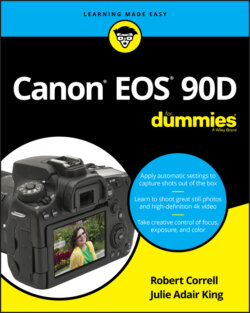Читать книгу Canon EOS 90D For Dummies - King Julie Adair, Robert Correll - Страница 38
FOCAL LENGTH AND THE CROP FACTOR
ОглавлениеThe angle of view that a lens can capture is determined by its focal length, or in the case of a zoom lens, the range of focal lengths it offers. Focal length is measured in millimeters. The shorter the focal length, the wider the angle of view. As focal length increases, the angle of view narrows, and the subject occupies more of the frame.
Generally speaking, lenses with focal lengths shorter than 35mm are considered wide-angle lenses and lenses with focal lengths greater than 80mm are considered telephoto lenses. Anything in the middle is a normal lens, suitable for shooting scenes that don’t require either a wide or narrow angle of view.
Note, however, that the focal lengths stated in this book and elsewhere are 35mm-equivalent focal lengths. Here’s the deal: When you put a standard lens on most dSLR cameras, including the 90D, the available frame area is reduced, as if you took a picture on a camera that uses 35mm film negatives and cropped it. This crop factor varies depending on the camera, which is why the photo industry adopted the 35mm-equivalent measuring stick as a standard. With the 90D, the crop factor is roughly 1.6x. In the figure here, the red frame indicates the portion of a 35mm frame that is captured at that crop factor.
When shopping for a lens, it’s important to remember this crop factor to make sure that you get the focal length designed for the type of pictures you want to take. Just multiply the lens focal length by 1.6 to determine the actual angle of view.
